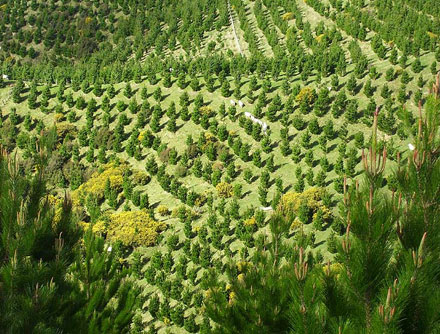
A review of global biosecurity undertaken by Scion Principal Scientist Dr Eckehard (Ecki) Brockerhoff and colleagues from the University of Pretoria highlights the urgent need for a global biosecurity strategy for planted forests. Source: Scion
The review was published recently in the journal ‘Science’.
“Forests worldwide are continually under threat from introduced insects and pathogens. Without a concerted global effort to control invasive pests, the problem will worsen as international trade increases,” Mr Brockerhoff said.
“Planted radiata pine forests have been successful partly because the trees have been separated from their natural pests. This also makes them vulnerable if these pests accidently arrive or the trees encounter new pests for which they have no resistance.
“Keeping forests secure relies on quarantine, treatment of imported goods, and monitoring insect traps and trees around ports and other high risk sites.
“New Zealand has some of the best biosecurity practices in the world but many other countries don’t maintain highly effective systems.
“Once a pest becomes established somewhere, it can be impossible to eradicate and can use the new country as a stepping stone for further invasions.”
Mr Brockerhoff says the future of planted forests will be influenced by our ability to respond to damaging pests and the threat of biological invasions.
The only way we can realistically deal with this will be through global collaborations, and the sharing of experience and research.
“Single-country strategies won’t be sufficient as the threats to planted and indigenous forests increase worldwide and it is unlikely that poorer countries can afford to maintain the level of biosecurity needed for total exclusion.”
Preparing for future invasions will require investment in research and innovation.
Scientists in New Zealand and overseas are using a wide variety of techniques combined with knowledge of tree genetics and forest ecosystems to develop non-chemical methods for controlling existing pests and preparing for future threats.
“We have excellent systems in place to prevent the arrival of forest pests and diseases, to respond to incursions, and to manage those that do become established,” Mr Brockerhoff said.
“But while bodies like the International Union of Forest Research Organisations (IUFRO) help facilitate collaboration, there is no single body or funding structure to support a global strategy for dealing with pests in planted forests.
“It is important for New Zealand to maintain strong international networks to address the biosecurity challenge collectively and, through science partnerships including the New Zealand Biological Heritage National Science Challenge, help countries that may not have the resources or expertise to put biosecurity measures in place.”





